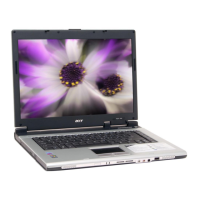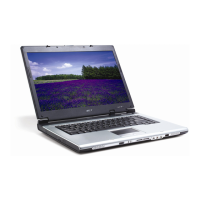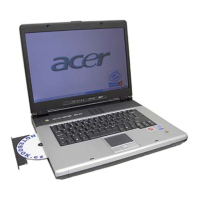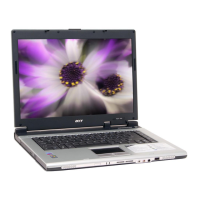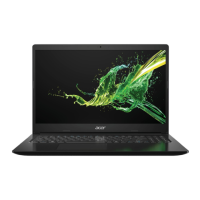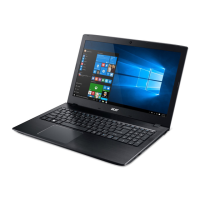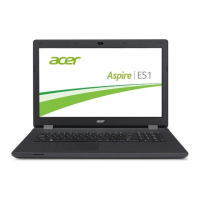What to do if other symptoms appear on Acer Aspire 1600?
- DdavidtaylorJul 30, 2025
If your Acer Laptop is showing other symptoms, such as LCD display problems, consult the “Power-On Self-Test (POST) Error Message” on page 85 for assistance.
What to do if other symptoms appear on Acer Aspire 1600?
If your Acer Laptop is showing other symptoms, such as LCD display problems, consult the “Power-On Self-Test (POST) Error Message” on page 85 for assistance.
What to do if diagnostic test on Acer Laptop displays a FRU code?
If the diagnostic test detected an error and displayed a FRU code, refer to the information on the “System Utility Diskette” on page 51 for guidance.
What to do if symptoms cannot be re-created on Acer Aspire 1600 Laptop?
If the symptoms cannot be recreated on your Acer Laptop, use the customer-reported symptoms and consult “Power-On Self-Test (POST) Error Message” on page 85, “Intermittent Problems” on page 92, and “Undetermined Problems” on page 93.
Introduction to user manuals and setup posters for the Aspire computer.
Instructions for powering the computer on and off using the power button.
Guidelines for protecting the computer from heat, cold, magnetic fields, and moisture.
Recommendations for maintaining the AC adapter and its power cord.
Advice on maintaining the computer's battery pack, including usage and disposal.
Steps for cleaning the computer and when to seek professional service.
Overview of the computer's external components and layout.
Identification of components visible from the top of the laptop.
Identification of components on the front of the laptop.
Identification of components on the left side of the laptop.
Identification of components on the right side of the laptop.
Identification of components on the back of the laptop.
Identification of components on the bottom of the laptop.
Summary of the computer's key specifications and capabilities.
Details about the laptop's screen and video capabilities.
Explanation of the status lights on the computer.
Description of the laptop's keyboard layout and keys.
Explanation of the numeric keypad functionality.
Description of special Windows function keys.
Explanation of function key combinations for quick access.
Information about the Euro currency symbol key.
Discussion on comfortable typing posture and palm rest.
Overview of the touchpad pointing device and its functions.
Instructions on how to use the touchpad for cursor movement and selection.
Description of programmable quick-launch buttons and their default applications.
How to insert and remove diskettes from the floppy disk drive.
Instructions for using the optical drive to play DVD movies.
Procedure for ejecting discs when the computer is turned off.
Connecting to a network via the integrated Ethernet port.
Using the built-in modem for phone line connections.
Information about the computer's integrated stereo audio system.
How to control the audio volume using the rotary control knob.
Using a Kensington lock slot for physical security against theft.
Setting up system passwords (Supervisor, User, Hard Disk) for protection.
Details about the removable Lithium-Ion battery pack.
Features of the computer's Lithium-Ion battery.
Tips to extend the battery lifespan through proper usage and care.
Initial setup procedure for new battery packs to ensure optimal performance.
Procedures for safely installing and removing the battery pack.
Steps and recommendations for charging the computer's battery.
How to view the current battery charge level using the Windows Power Meter.
Further suggestions for optimizing battery operational time and longevity.
Actions to take when the battery-low warning appears.
Connecting external monitors or projectors to the computer.
Outputting video signals to televisions or displays with S-video input.
Connecting various input devices like keyboards and mice via USB.
Connecting an external keyboard to enhance typing comfort and features.
Connecting an external numeric keypad for easier data entry.
Connecting an external mouse or other pointing device via USB.
Connecting printers via USB or parallel ports.
Connecting external audio input and output devices.
Overview of expansion capabilities like PC Card slots.
Information on using PC Card slots for Type II and Type III cards.
Connecting various peripherals using Universal Serial Bus (USB) ports.
Connecting IEEE 1394 supported devices like digital video cameras.
Importance of having a spare battery for travel.
Benefit of having a spare AC adapter for use in multiple locations.
Options for upgrading key hardware components for better performance.
Instructions on how to install additional memory modules.
Information on replacing the hard disk drive with a higher capacity one.
Steps to safely disconnect peripherals before moving the computer.
Tips for moving the computer short distances without shutting down.
General preparation steps for moving the computer.
Items to bring for short meetings, assuming a fully charged battery.
Items to bring for longer meetings, including AC adapter.
Preparing the computer for short trips between office and home.
Specific steps for packing the computer for transit.
Recommended items to carry when taking the computer home.
Precautions to protect the computer during transit.
Advice on setting up a home office, including spare adapters and peripherals.
Tips for making longer trips with the computer.
General preparation steps for traveling with the computer.
Recommended items to pack for travel.
Travel-specific precautions, including luggage and security checks.
Tips and considerations for international travel with the computer.
Preparation steps for international travel.
Recommended items for international travel.
International travel precautions for power, phone lines, and media.
Information on pre-loaded system software like Windows and utilities.
Software for configuring the computer's launch keys.
Hardware configuration program built into the computer's BIOS.
BIOS screen displaying a summary of computer hardware information.
BIOS screen for setting basic system parameters like date and time.
BIOS screen containing parameters related to hardware features.
BIOS screen for setting passwords to protect the computer.
BIOS screen for determining the order of bootable devices.
BIOS screen for saving or discarding changes and exiting the utility.
Solutions to commonly encountered problems with the computer.
List of BIOS error messages and their corresponding corrective actions.
| CPU | Intel Pentium 4 |
|---|---|
| RAM | 256 MB DDR SDRAM, expandable to 1 GB |
| Hard Drive | 40 GB |
| Operating System | Windows XP Home Edition |
| Battery Life | 2.5 hours |
| Graphics | ATI Mobility Radeon 9000 |
| Graphics Card | Intel Extreme Graphics 2 |

